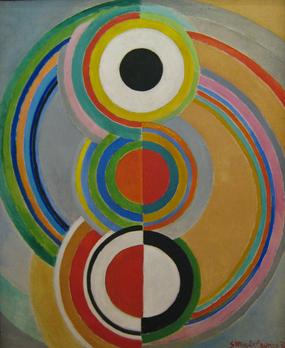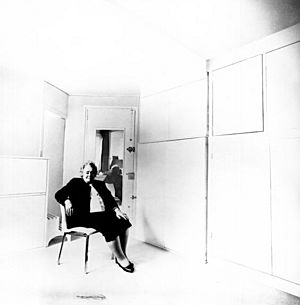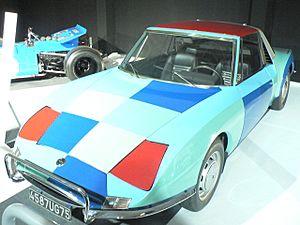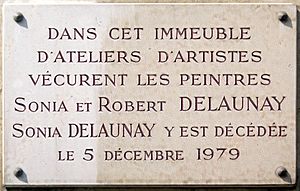Sonia Delaunay facts for kids
Quick facts for kids
Sonia Delaunay
|
|
|---|---|
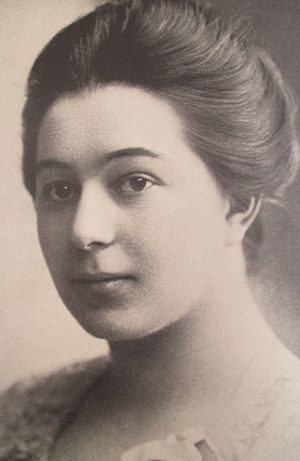
Sonia Terk, c.1912
|
|
| Born |
Sarah Ilinitchna Stern
14 November 1885 Hradyzk, Poltava Governorate, Russian Empire
|
| Died | 5 December 1979 (aged 94) Paris, France
|
| Nationality | Russian, French |
| Known for | Painting |
| Movement | Orphism |
Sonia Delaunay (born November 14, 1885 – died December 5, 1979) was a French artist. She spent most of her life working in Paris. She first studied art in Russia and Germany. Later, she moved to France. There, she started working with textiles, fashion, and even stage design.
Sonia Delaunay helped create the Orphism art movement. This style is known for using bright colors and geometric shapes. She started it with her husband, Robert Delaunay, and other artists. In 1964, she became the first living female artist to have a special exhibition at the Louvre museum. In 1975, she received a high honor called the French Legion of Honor. Her modern designs included using abstract shapes. She also combined art with furniture, fabrics, wall coverings, and clothing.
Contents
Sonia Delaunay's Life and Art
Early Years (1885–1904)
Sonia Delaunay was born as Sarah Ilinitchna Stern on November 14, 1885. She was born in Hradyzk, which was then part of the Russian Empire. Her father worked as a factory foreman. When she was young, she moved to St. Petersburg. There, her mother's brother, Henri Terk, and his wife Anna took care of her. They adopted her in 1890, and she took the name Sonia Terk.
Sonia had a good childhood. Her family spent summers in Finland and traveled around Europe. This allowed Sonia to visit many art museums and galleries. At 16, she went to a good school in St. Petersburg. Her drawing skills were noticed by her teacher. When she was 18, her teacher suggested she go to art school in Germany. She studied at the Academy of Fine Arts in Karlsruhe until 1905. Then, she moved to Paris.
Starting in Paris (1905–1910)
In Paris, Sonia joined the Académie de La Palette art school. But she didn't like the way they taught, finding it too critical. So, she spent more time visiting art galleries in Paris. Her early paintings were inspired by artists like Van Gogh, Gauguin, and Henri Rousseau. She also liked the bright colors used by the Fauves artists, such as Matisse.
In 1908, she married Wilhelm Uhde, a German art dealer. This marriage helped her get access to her own money. It also helped her enter the art world. She showed her art at Uhde's gallery and used his connections. In 1909, Sonia met Robert Delaunay. They fell in love, and she divorced Uhde in 1910. Sonia and Robert married on November 15, 1910. Their son, Charles, was born in 1911. Sonia's aunt sent them money from St. Petersburg to help them.
Sonia once said about Robert: "In Robert Delaunay I found a poet. A poet who wrote not with words but with colours."
Creating Orphism (1911–1913)
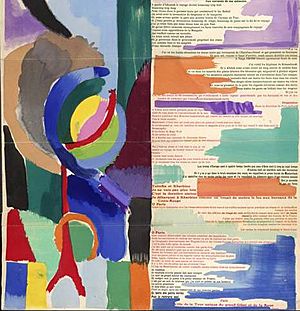
In 1911, Sonia Delaunay made a patchwork quilt for her son Charles's crib. This quilt is now in the Musée National d'Art Moderne in Paris. She made it using geometric shapes and colors. Sonia said that making the quilt made her think of Cubist art. She then tried to use the same ideas in her paintings and other objects.
Art experts see this quilt as a turning point for Sonia. It was when she moved away from traditional art styles. Around this time, Cubist art was popular in Paris. Robert Delaunay was also studying how colors work together. They called their color experiments simultanéisme. This idea means that colors placed next to each other affect how both are seen. Sonia's first big painting in this style was Bal Bullier (1912–13). It is known for its use of color and sense of movement.
In 1913, their friend, the poet Guillaume Apollinaire, gave their art style a name: Orphism. He used this term to describe their unique version of Cubism. Through Apollinaire, Sonia met the poet Blaise Cendrars in 1912. They became good friends and worked together. Sonia said Cendrars's work gave her "a push, a shock."
She illustrated Cendrars's poem La prose du Transsibérien et de la Petite Jehanne de France. This poem was about a journey on the Trans-Siberian Railway. Sonia created a 2-meter-long book that folded out like an accordion. It combined text and design using her simultaneous style. This book caused a lot of excitement among art critics in Paris. It was later shown in Berlin in 1913, along with her paintings and other designs like dresses. It is said that artist Paul Klee was very impressed by her use of squares in the book's binding. These squares later became a common feature in his own art.
Years in Spain and Portugal (1914–1920)
In 1914, the Delaunays traveled to Spain. They were staying in Hondarribia when the First World War began. They decided not to return to France. In 1915, they moved to Portugal. There, they lived with other artists and discussed art. In Portugal, Sonia painted Marché au Minho (Market in Minho, 1916). She said this painting was "inspired by the beauty of the country." Sonia also had her own art show in Stockholm in 1916.
The Russian Revolution in 1917 stopped the money Sonia received from her family. She needed a new way to earn money. In Madrid, the Delaunays met Sergei Diaghilev, a famous ballet producer. Sonia designed costumes for his shows, like Cleopatra and Aida. In Madrid, she also decorated a nightclub called the Petit Casino. She then started her own business, Casa Sonia. It sold her designs for home decoration and fashion. She even opened a branch in Bilbao.
In 1920, Sonia went to Paris to find opportunities in the fashion world. She wanted to expand her business. The same year, a gallery in Berlin showed works by Sonia and Robert from their time in Portugal.
Back in Paris (1921–1944)
Sonia, Robert, and their son Charles moved back to Paris for good in 1921. They solved their money problems by selling a painting by Henri Rousseau. Sonia started making clothes for private clients. In 1923, she created 50 fabric designs using geometric shapes and bold colors for a manufacturer. Soon after, she started her own business. Her simultané style became her official trademark.
She designed sets and costumes for a play called Le Cœur à Gaz in 1923. In 1924, she opened a fashion studio with Jacques Heim. Famous people like Gloria Swanson were her customers.
In 1925, Sonia and Heim had a special display called boutique simultané at a big art exhibition. Sonia also gave a speech at the Sorbonne about how painting influenced fashion. She explained that she used geometric shapes because they were good for arranging colors. She said the colors were the most important part of her art.
Sonia designed costumes for two films and some furniture for another. She also designed fancy textiles for Robert Perrier. The Great Depression caused her business to slow down. After closing her business, Sonia went back to painting. But she still designed for other companies and private clients. She said the depression "freed her from business."
By 1934, Sonia was working on designs for a big exhibition in 1937. She and Robert worked together to decorate two large buildings. Sonia chose to help Robert without being tied to a contract. She said, "I am free and mean to remain so." Many other artists helped paint the murals for the exhibition. Robert Delaunay died in October 1941.
Later Life and Legacy (1945–1979)
After World War II, Sonia was on the board of an art group for several years. In 1964, Sonia and her son Charles gave 114 artworks by Sonia and Robert to the Musée National d'Art Moderne. Another artist told her that she and Braque were the only living painters to have their work shown at the Louvre.
In 1966, she published a book of her color designs. In 1969, she published another book about her "poem-dresses." She even decorated a Matra 530 car. In 1975, Sonia received the French Legion of Honor. From 1976, she created textiles, dishes, and jewelry inspired by her 1920s work. Her autobiography, Nous irons jusqu'au soleil (We shall go up to the sun), came out in 1978.
In 1967, Sonia was part of an exhibition of artist-decorated cars. She designed the pattern for a Matra 530 car. She wanted the pattern to look light blue when the car was moving. This was so it wouldn't distract other drivers.
Sonia Delaunay died on December 5, 1979, in Paris. She was 94 years old. She was buried next to Robert Delaunay's grave. Her son, Charles Delaunay, became an expert in jazz music. He was a jazz critic and helped start the first jazz club in France.
Legacy
In 2004, Sonia Delaunay's painting Coccinelle was featured on a stamp. This stamp was released by France and the United Kingdom. It celebrated 100 years of friendship between the two countries.
Art Shows
Sonia Delaunay's art was part of a group exhibition called Dada is Dada. This show was held at Bildmuseet in Sweden from 2017 to 2018.
See also
- In Spanish: Sonia Delaunay para niños



